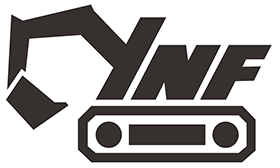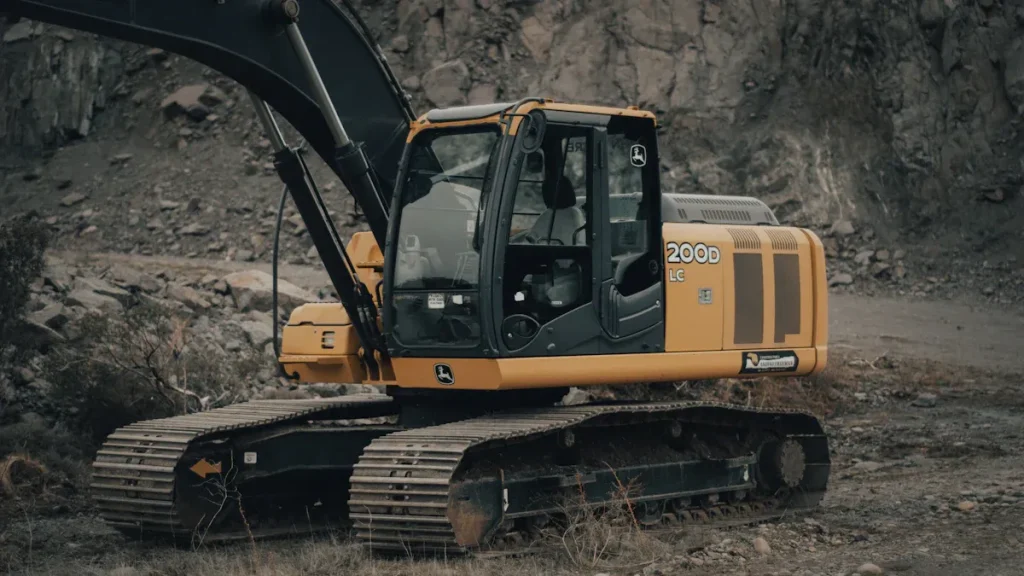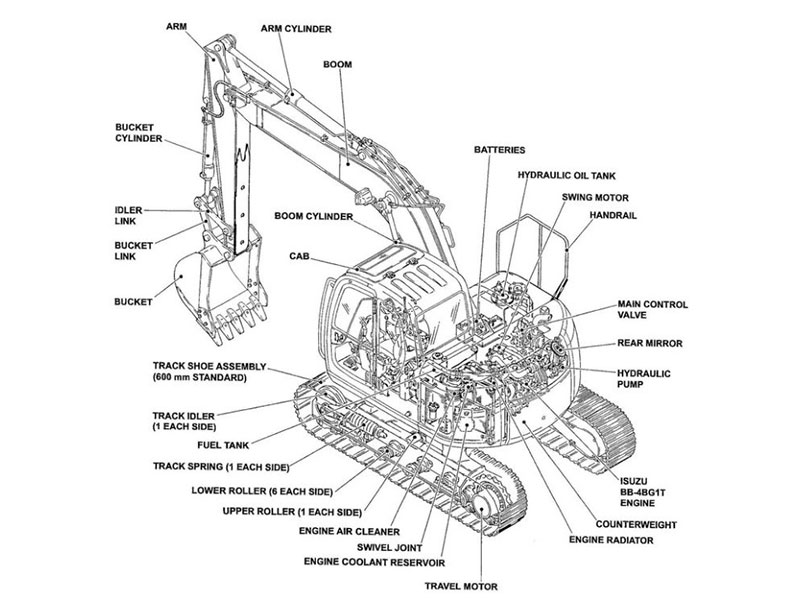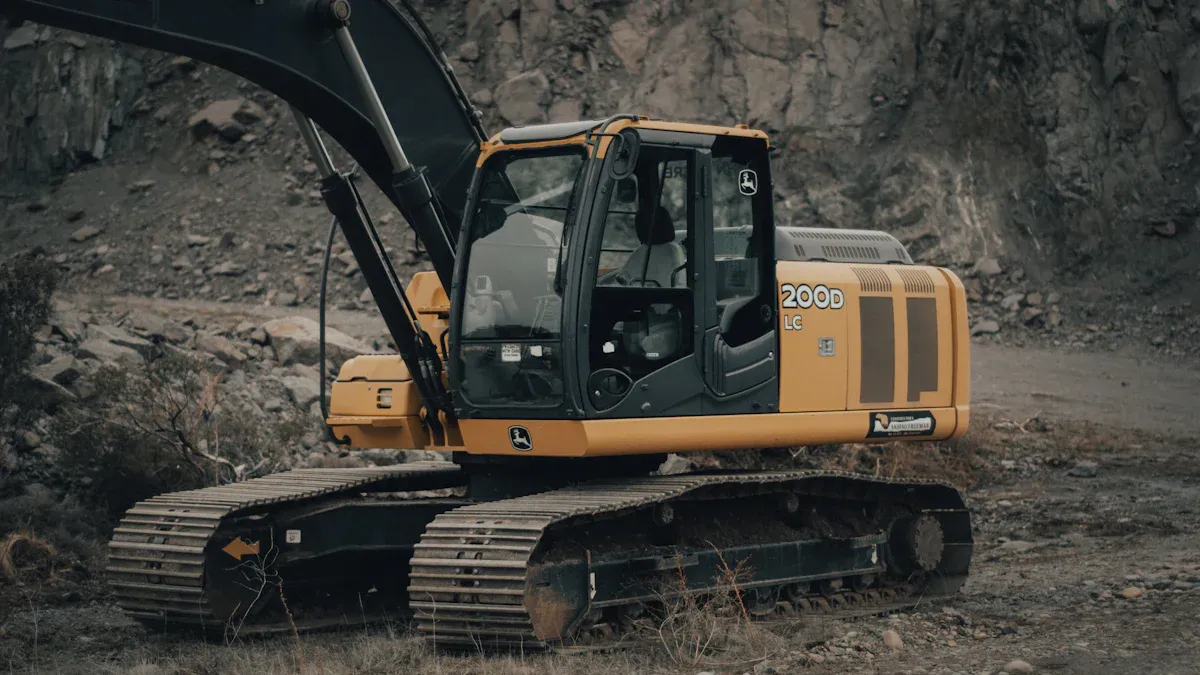
Excavators have many important body parts. Each part has its own job. The main parts of an excavator are the boom, arm, bucket, cab, undercarriage, engine, hydraulic system, counterweight, swing gear, and sometimes a blade. The table below lists the main body parts of an excavator and what they do:
Main Excavator Part | Function |
|---|---|
Boom | Stretches out to help dig and lift. |
Arm (Stick) | Links the boom to the bucket and sets depth. |
Bucket | Digs, scoops, and moves things. |
Cab | Holds the operator and the controls. |
Undercarriage | Holds up the weight and lets it move. |
Engine | Gives power to the excavator. |
Hydraulic System | Moves the boom, arm, and bucket. |
Counterweight | Keeps the machine balanced. |
Swing Gear | Turns the excavator around. |
Blade | Smooths and levels the ground. |
Knowing the body parts of an excavator and what they do helps people use the machine safely. It also helps keep the excavator working well. If you know the basic parts, you can spot problems faster. You can also pick the right parts for different jobs.
Key Takeaways
Excavators have many important parts. These include the boom, arm, bucket, cab, undercarriage, engine, hydraulic system, and counterweight. Each part has a special job. They help the machine dig, lift, and move things.
The undercarriage has tracks, rollers, sprockets, and idlers. It holds up the machine. It helps the excavator move over rough ground. Checking these parts often stops expensive repairs.
The operator’s cab keeps the driver safe and comfortable. It has things like climate control and cameras. The counterweight helps the excavator stay balanced when lifting heavy things.
Hydraulic systems make the excavator move. Taking care of pumps, lines, and cylinders is important. This keeps the machine strong and smooth. It also stops it from breaking down.
Attachments like buckets, hammers, and grapples make the excavator do more jobs. One machine can do many tasks safely and well.
Main Components of an Excavator: Undercarriage
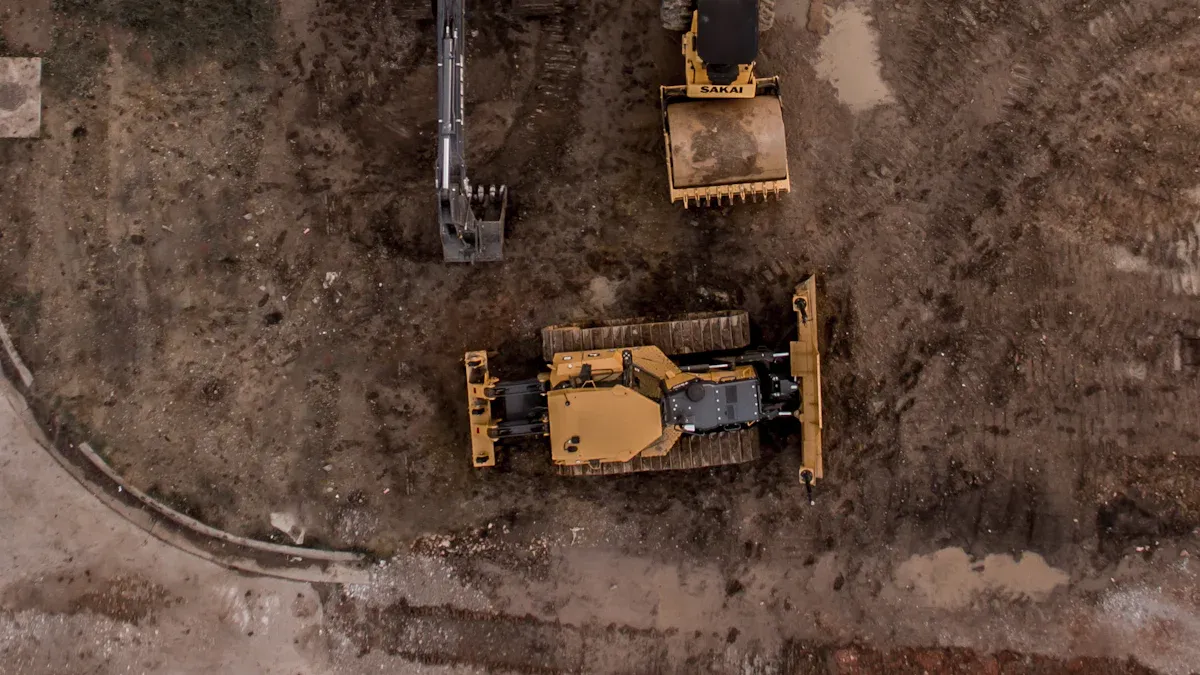
The undercarriage is the bottom part of a track excavator. It holds up the whole machine and lets it move on many surfaces. The main parts of the undercarriage are tracks, rollers, sprockets, and idlers. Each part helps the machine stay steady and move well.
Tracks and Rollers
Tracks run along both sides of the undercarriage. They help the track excavator travel over mud, rocks, or sand. Track shoes grip the ground and stop slipping. Rollers sit under the tracks and hold up the excavator’s weight. They spread out the weight so the ground does not get damaged. This helps the machine move smoothly. These parts are made from strong steel that does not wear out fast. The steel keeps the parts working even in tough places and makes them last longer.
Sprockets and Idlers
Sprockets push the tracks forward or backward. They get power from the engine and send it to the tracks. Idlers are at the ends of the tracks and keep them tight. They guide the tracks and stop them from falling off. Sprockets and idlers must be in good shape for the track excavator to work right. If they break, the machine can lose control or stop moving.
Tip: Check and clean sprockets and idlers often. This can stop problems and save money on repairs.
Stability and Mobility
The undercarriage design gives the track excavator a strong grip and balance. Roller wheel tracks spread the weight over a big area. This keeps the excavator steady on soft or bumpy ground. Track rollers help the machine move over rocks or bumps without sinking. The undercarriage lets the excavator work where wheeled machines cannot go.
Different ground types can wear out undercarriage parts. Rocks can dent or scratch tracks and rollers. Mud can cause rust and make tracks loose. Hard clay or frozen dirt can crack track pads. Sand and gravel can wear down metal fast. Most undercarriage parts last 2,000 to 6,000 hours. Good care and strong materials can make them last longer.
Component | Average Lifespan (hours) |
|---|---|
Track Shoes | 2,000 – 3,000 |
Rollers | 3,000 – 5,000 |
Idlers | 4,000 – 6,000 |
Sprockets | 3,000 – 4,000 |
Track Chains | 3,000 – 5,000 |
The main parts of an excavator undercarriage help it work in hard places. Picking a good supplier, like YNF Machinery, helps you get strong and long-lasting excavator parts for any job.
Key Parts of an Excavator: Cab and Counterweight
Operator’s Cab
The operator’s cab sits on top of the excavator. It keeps the operator safe from rain, dust, and loud sounds. New cabins are made to help operators feel good and work longer. Many cabins have:
Seats that heat or cool and help with back pain
Big screens that are easy to see and use
Armrests and footrests that move for better comfort
Air systems that keep the temperature just right
Less noise and shaking to stop tiredness
Cameras all around for better safety and seeing more
Some cabins also have places to store things, wireless charging, and Bluetooth for calls. These features help operators pay attention and not get tired. The cabin’s design makes it easier to use the excavator and helps stop mistakes.
Counterweight
The counterweight is a big, heavy block on the back of the excavator. It helps balance the machine when it lifts or digs. The size and spot of the counterweight are important for balance. A good counterweight lets the machine lift more without falling over. Some counterweights can move or change for different jobs. This helps the machine stay steady, even when the bucket is far away. A strong counterweight also keeps other parts from breaking, so the excavator lasts longer.
Tip: Always make sure the counterweight fits the job. The right counterweight keeps the machine safe and steady.
360-Degree Rotation
The top part of the excavator can spin all the way around. This spinning uses hydraulic motors and slewing bearings. These parts help the cab and boom turn easily and carry heavy things. Operators can dig or move things without moving the whole machine. This saves time and fuel. The spinning system also helps in small spaces, so the excavator can do more jobs. Easy controls and strong bearings help the top part work well and last longer.
The main parts of an excavator, like the cab, counterweight, and spinning system, work together to keep the machine safe, steady, and working well. Many people pick YNF Machinery for strong and long-lasting excavator parts.
Body Parts of an Excavator: Boom, Arm, and Bucket
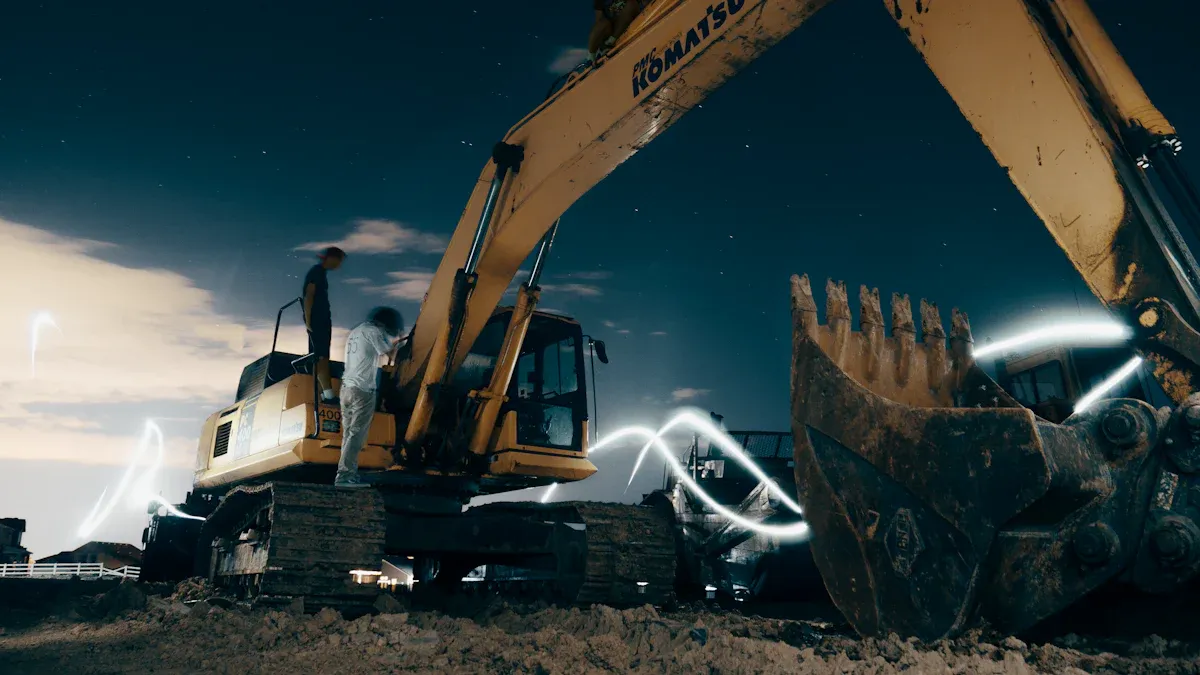
The boom, arm, and bucket are the main working parts on top of the excavator. These parts work together to help the machine dig, lift, and move things. The boom and arm let the excavator do these jobs with strength and accuracy.
Boom
The boom is a big, slanted part that links the top of the excavator to the arm. It is the main part that lifts and lowers the arm and bucket. Most booms are made from strong steel so they last a long time. The boom is shaped like an upside-down “V” to spread out weight and hold heavy loads.
Excavator Class | Boom Length (meters) | Typical Load Capacity Examples | Additional Notes |
|---|---|---|---|
Mini/Compact (1-6t) | 1.5 – 3 | N/A | Smaller machines with shorter booms for light-duty tasks |
Medium (20-30t) | 5 – 6 | Lifting ~5 tons at 5m radius (e.g., 25t machine) | Boom length ~5.5m with 3m arm; breakout force 20-30 kN; horizontal reach up to 12m |
Heavy-duty (50+t) | 7 – 9 | N/A | Used in mining and large construction; long booms for deep digging and high structural integrity |
Booms use hydraulic cylinders to move up and down. The joints have special bearings or bushings to help them move smoothly. The boom is important for both digging and lifting. Medium excavators are good for many jobs because they can reach far and lift heavy things. The boom stays steady with a low center of gravity and the right counterweight.
Note: Check the boom and its cylinder often. This helps stop sudden problems and keeps lifting safe.
Arm (Stick/Dipper)
The arm, also called the stick or dipper, connects to the end of the boom and holds the bucket. The arm decides how far the bucket can reach and how deep it can dig. It must be strong to pull dirt and not bend when digging.
Aspect | Influence of Arm (Stick/Dipper) Length |
|---|---|
Horizontal Reach | Longer arms increase maximum horizontal reach, allowing access to areas further from the excavator base. Long-reach models can have 1.5-2 times the reach of standard models (e.g., 15,300mm to 17,300mm vs. standard limits). |
Digging Depth | Longer arms enable deeper excavation below ground level, with long arm excavators achieving depths around 11,200mm to 12,200mm. |
Digging Force | Digging force typically decreases with longer arms due to increased leverage distances, but advanced hydraulics help mitigate this loss. |
Structural Considerations | The arm experiences tensile forces and bending moments during digging, requiring reinforcement to maintain integrity. |
Stability | Longer arms require enhanced counterweights and sometimes wider undercarriages or outriggers to maintain stability during extended reach operations. |
Application Examples | Long arm excavators are specialized for tasks like dredging, slope stabilization, and environmental remediation, where extended reach and depth are critical. |
Longer arms help the excavator reach farther and dig deeper. But longer arms also put more stress on the machine. Strong hydraulics help keep digging power high, even with long arms. Machines with long arms need bigger counterweights or wider bases to stay steady.
Bucket
The bucket is at the end of the arm and does the digging and scooping. It picks up and dumps things like dirt, rocks, or trash. There are many kinds of buckets for different jobs. Some buckets are big for moving lots of loose stuff. Others are thin for digging narrow holes. Swamp buckets work best in wet, soft ground. Cleanup buckets help smooth and level the ground. Some buckets have strong teeth and sharp edges for hard dirt or rocks.
Picking the right bucket size and type makes work safer and faster. If the bucket is too big, the machine can tip over. If it is too small, the job takes longer. The right bucket helps dig better and lasts longer. Special buckets help the excavator do more jobs and last longer.
Tip: Always use a bucket that fits the job and the machine. This keeps work safe and helps get more done.
Hydraulic Cylinders
Hydraulic cylinders make the boom, arm, and bucket move. Each joint has a cylinder to control how it moves. The boom cylinder lifts and lowers the boom. The arm cylinder moves the arm in and out. The bucket cylinder tips the bucket to dig or dump. These cylinders use oil under pressure to make strong, smooth moves.
Hydraulic cylinders must handle a lot of pressure and work all the time. They have seals and smooth rods to stop leaks and wear. Taking care of these parts keeps the excavator working well and stops costly repairs. The cylinders help the operator dig, lift, and move things with control.
Alert: If a cylinder leaks or breaks, the machine loses power and can be unsafe. Check cylinders often and fix leaks fast.
The boom, arm, bucket, and hydraulic cylinders are the main working parts of the excavator. These parts let the machine dig hard, lift well, and move things easily. Many people trust YNF Machinery for strong and long-lasting excavator parts.
Essential Parts of an Excavator: Hydraulic System
The hydraulic system is very important in an excavator. It gives power to the boom, arm, bucket, and cylinder. This lets the machine lift and dig heavy things. If the hydraulic system is weak, the excavator cannot work well. The hydraulic system links the top and bottom parts. It sends power to the right places so the machine works smoothly.
Hydraulic Pumps
Hydraulic pumps are the main part of the system. They push oil through tubes to move the cylinder and other parts. Excavators use different kinds of pumps:
Gear pumps are simple and quiet. They are good for small machines but cannot handle high pressure.
Vane pumps run smoothly and take more pressure than gear pumps. They are not as efficient.
Piston pumps are best for most excavators. They handle high pressure and last a long time. They work well in hard jobs. For example, the Rexroth-Uchida AP2D pump fits mini and midi excavators. The Kawasaki K3V and K5V series work in bigger machines with more flow.
Pick the right pump for the size and job of the excavator. The pump’s flow rate and pressure must match the machine for best results.
Hydraulic Lines
Hydraulic lines carry oil from the pump to the cylinder and back. These lines must be strong and not leak. Good hydraulic lines help the excavator move well:
Pressure in the lines gives the machine strength to lift and break hard ground.
Flow rate controls how fast the boom, arm, and bucket move.
Good lines keep pressure and flow steady. This makes movements strong and quick.
Leaks or clogs slow down the machine and make movements weak or jumpy.
Check hydraulic lines often and keep them in good shape. Clean oil and tight fittings stop many problems.
Powering Movement
The hydraulic system makes every part of the excavator move. It sends oil to the cylinder. The cylinder moves the boom, arm, and bucket. Problems in the hydraulic system can stop the machine or make it unsafe. Common problems are leaks, overheating, and dirty oil. The table below shows some causes and ways to stop them:
Common Cause | Explanation | Prevention Methods |
|---|---|---|
Contamination | Dirt or water gets in through bad seals or filters. | Use good filters, change them often, and keep things clean. |
Overheating | Oil gets too hot and causes damage. | Use coolers, check oil levels, and watch the temperature. |
Fluid Leaks | Bad seals or loose hoses let oil out. | Check often, use good parts, and tighten fittings. |
Air in System | Air bubbles make movements jumpy and cause damage. | Bleed the system after repairs and check for leaks. |
Wrong Fluid | Using the wrong oil causes wear and poor work. | Always use the oil the maker says to use. |
Big brands like Caterpillar, Komatsu, and Hitachi use smart hydraulic systems. They add sensors, strong parts, and easy ways to fix things. This helps the excavator work safely for a long time.
Tip: Take care of the hydraulic system often. This stops breakdowns and keeps the excavator working well.
YNF Machinery has strong and reliable hydraulic system parts for excavators.
Attachments and Versatility
Excavators do more than just dig holes. Attachments let them do many jobs. These machines work on building sites, tearing down things, and fixing land. Operators can change attachments to lift, break, sort, or drill. This makes one excavator do many tasks. It saves time and money because you need fewer machines.
Common Attachments
Excavators use many attachments to help with work. Each attachment is good for a certain job. The table below lists common attachments and what they do best:
Attachment Type | Common Uses / Optimized Tasks |
|---|---|
Buckets | Digging, grading, moving soil or rocks |
Hammers (Breakers) | Breaking concrete, asphalt, or rock during demolition |
Thumbs | Picking up and placing large objects, helpful in demolition and forestry |
Grapples | Sorting and moving logs, rocks, debris; used in recycling and forestry |
Augers | Drilling holes for posts or trees in landscaping and construction |
Operators switch attachments to fit the job. Buckets dig and move dirt. Hammers break hard things. Grapples pick up big items. Augers drill holes fast.
Tip: Quick attach systems help workers change tools quickly. This makes the excavator more useful.
Specialized Tools
Some jobs need special tools, not just digging or lifting. These attachments help with hard or tricky tasks:
Demolition Grapples: These grab and move heavy debris. They help control odd-shaped things.
Material Handling Grapples: These pick up rocks, wood, or scrap. They help sort things and stop damage.
Root Grapples: These have strong teeth for clearing stumps and roots. They are great for forestry.
Hydraulic Breakers: These use pistons to break concrete or rock. Operators use different tips for crushing or cutting.
Mulchers and Brush Cutters: These cut thick brush and small trees to clear land.
Plate Compactors and Rippers: These pack soil or break hard ground. They help get sites ready for building.
Grapples and breakers make excavators do more jobs. Grapples act like jaws and grip things tightly. Breakers hit hard to break tough surfaces. These tools help finish work faster and easier.
Manufacturers test new attachments to make sure they fit well. They check the hydraulic system, weight, and how they mount. Operators try attachments before buying to see how they work.
Note: Always pick attachments that fit the job and follow rules. The right tool keeps the site safe and protects nature.
YNF Machinery has many strong and reliable excavator attachments for every job.
Understanding what each main body part does helps people use excavators safely.
The counterweight stops the machine from tipping over.
Tracks and rollers help keep the excavator steady.
Hydraulic systems and checking parts often help prevent accidents.
Training teaches operators how to use these parts well. Daily checks help find problems early. Taking care of the excavator saves money and makes it last longer. Many workers pick YNF Machinery for strong and trusted parts.
FAQ
What is the most important part of an excavator?
All parts are important, but the hydraulic system gives power. Without strong hydraulics, the boom, arm, and bucket will not work. They cannot move or lift heavy things.
How often should operators check excavator parts?
Operators need to check main parts every day before work. Daily checks help find leaks, cracks, or loose bolts early. This keeps the machine safe and working well.
Can one excavator use different attachments?
Yes. Operators can change attachments like buckets, hammers, or grapples. This lets one excavator do many different jobs. Quick couplers make switching tools fast.
Why does the counterweight matter?
The counterweight helps keep the excavator balanced. It stops the machine from tipping when lifting or digging. A good counterweight helps the operator work safely.
Where can someone buy strong excavator parts?
YNF Machinery sells strong excavator parts and attachments. Many operators trust this company for quality and long-lasting products.
